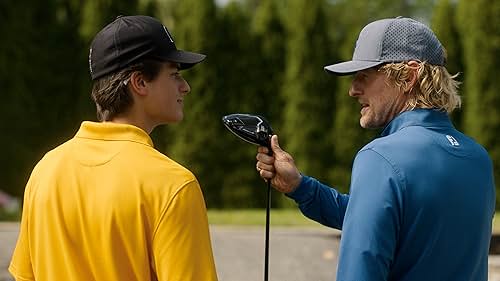The new Apple TV+ series Stick is stuck on the trauma plot, and it’s sparking plenty of chatter among viewers and critics alike. Launched on June 4, 2025, this golf comedy-drama starring Owen Wilson as Pryce Cahill, a washed-up former pro golfer, has drawn comparisons to Ted Lasso for its feel-good vibe. Yet, recent reviews highlight a persistent issue: the show’s heavy reliance on emotional backstories and unresolved pain, which some argue overshadows its lighthearted premise. Let’s dive into why Stick is stuck on the trauma plot and what that means for its early reception.
A Feel-Good Show with a Heavy Heart
Stick follows Pryce as he mentors Santi Wheeler, a 17-year-old golf prodigy played by Peter Dager. The show’s first three episodes, available now on Apple TV+, set up a classic underdog story. Pryce, grappling with a tarnished career and a looming divorce, sees Santi as his shot at redemption. Meanwhile, Santi carries his own baggage from an absentee father who once coached him. Critics note that the show leans hard into these emotional wounds, making trauma a central driver of the narrative. This approach, while poignant, risks feeling formulaic in a TV landscape saturated with similar storytelling.
The chemistry between Wilson and Dager shines, delivering heartfelt moments that resonate with fans of sports comedies. However, the show’s insistence on circling back to past pain—like Santi’s fraught history with his father or Pryce’s implied gambling issues—can feel like a boomerang, halting the story’s momentum. Reviewers praise the humor and charm but question whether the trauma plot overshadows the golfing fun.
The Trauma Plot: A Double-Edged Sword
The phrase Stick is stuck on the trauma plot comes from critiques that the show can’t resist digging into its characters’ emotional scars. In episode three, a pivotal moment sees Santi lash out at Pryce after a tournament win, a reaction tied to his father’s harsh coaching style. This scene, while powerful, underscores how the show prioritizes psychological depth over lighter, comedic beats. The trauma plot—where characters’ actions stem from past wounds—has become a TV staple, seen in shows like The White Lotus and Severance. For Stick, this framework adds depth but also predictability.
Fans on social media have mixed feelings. Some love the emotional layers, with posts calling the show a “heartwarming journey” that tackles real issues like toxic masculinity and abandonment. Others feel it tries too hard to be profound, with one viewer tweeting, “Let Stick be a fun golf show, not a therapy session!” The show’s creators, led by Jason Keller, aimed to explore characters who haven’t lived up to expectations, but the heavy focus on grief and loss sometimes overshadows the cozy, Happy Gilmore-esque vibe promised in early reviews.
Balancing Heart and Humor
Despite the critiques, Stick has its strengths. Owen Wilson’s signature charm carries the show, making Pryce a lovable, flawed mentor. The ensemble, including Marc Maron as the quirky caddy Mitts and Judy Greer as Pryce’s ex-wife Amber-Linn, adds warmth and wit. The show’s road-trip format, with the characters traveling in an RV for tournaments, creates a found-family dynamic that’s easy to root for. Yet, when the narrative veers into heavy themes—like Santi’s struggle with his father’s abandonment or Pryce’s career meltdown—it can feel like the show is trying to be more than a sports comedy.
The production values are top-notch, with lush golf course visuals and a soundtrack that captures the sport’s relaxed yet competitive spirit. A real-life golf coach, Nathan Leonhardt, was brought on to ensure the swings and lingo feel authentic, which golfers appreciate despite minor inaccuracies. Still, the show’s emotional detours can make it feel like it’s stuck in the rough, unable to fully embrace its potential as a breezy, uplifting watch.
What’s Next for Stick?
With seven episodes left in its 10-episode first season, Stick has room to find its footing. The weekly release schedule—new episodes drop every Wednesday, often a bit early—keeps viewers hooked. Critics suggest that leaning into the hangout comedy elements, like the playful banter between Pryce and Mitts, could lighten the mood. There’s also potential for richer subplots, like Pryce’s dynamic with his rival, played by Timothy Olyphant, to add stakes without relying on past trauma.
The show’s early Rotten Tomatoes score reflects a warm reception, with praise for its heart and humor, but reviewers warn that the trauma plot could wear thin if overdone. Fans are hopeful that Stick will balance its emotional depth with more golfing hijinks, especially with Happy Gilmore 2 looming as a competitor later in July 2025. For now, Stick is stuck on the trauma plot, but it’s not out of the game yet.
Stream Stick on Apple TV+ to see if Pryce and Santi can swing past their pasts and into a brighter future. Share your thoughts on social media—does the trauma plot work for you, or do you want more fairway fun?
